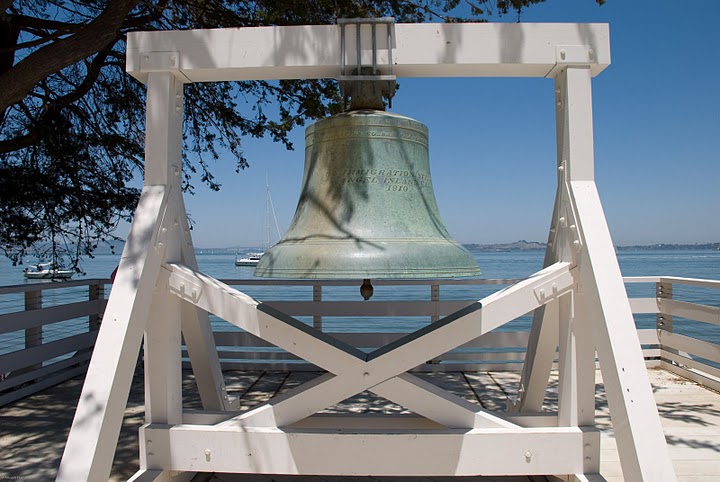Where: Angel Island Immigration Station Museum
When: All year, by appointment
Who: 4th graders and up (recommended for museum, parents can explore with younger children)
Cost: Ferry (roundtrip $9/student, $14/adult, $9/senior) + Museum tour ($3/person) + optional shuttle ($12/person). Prices as of October 2022.
The Angel Island Immigration Station Museum had been closed throughout the pandemic, and although we appreciated PORTS' virtual tours, we knew an in-person visit would feel entirely different. Hence we planned early for this field trip as it is wildly popular.
Our field trip started at Gate B of the San Francisco Ferry Building (1 Ferry Building, San Francisco) to take the 9:20 AM Golden Gate Ferry service to Angel Island. It was a beautiful morning, and the children immediately made for the upper decks where they could see San Francisco receding in the distance.
The ferry ride takes 30 minutes, and was calm enough that none of our group felt queasy. The ferry passes by Alcatraz and the western coast of Angel Island before docking at Ayala Cove which is on the northwestern tip of the island.
Since we had prebooked a tour of the Immigration Station, a ranger met us at the Cove to walk with us to the Immigration Station. Before we started the walk, we also redeemed shuttle tickets we had pre-booked for the members of our party who would ride instead of walk the 1.2 miles to the station.
Then we were off - the ranger led us up a path with several steps (we lost count). This part of the trail is not accessible or stroller friendly, however, there is a road (which the shuttle takes) that families can opt to walk. As we walked, the ranger told us about the wildlife and history on the island.
 |
| View from halfway up the stairs - Tiburon in distance |
As we approached the Immigration Station, the signs and barbed wire were a stark reminder of its past.
At the station, our guide thoughtfully discussed the push/pull forces behind immigration, the history of Pacific immigration and the Chinese Exclusion Act. We recommend pre-reading the excellent curriculum guides by the Angel Island Immigration Station Foundation because they set the stage for this discussion, e.g. the economic and political factors leading up to the anti-Chinese policy, the disruption brought by the 1903 earthquake, and the byzantine questions that could lead to immigrants being detained for weeks, months or even years. And yet, in the end, there was as 93% rate of admittance, a testament to perseverance. With those statistics in mind, we went up the stairs and into the barracks.
The recommended age for touring the museum is 4th grade and up. One of the reasons could be its set up - artifacts are laid out as though the occupants of the barracks had just stepped out for lunch, with unmade beds and open trunks strewn around. We marveled at how closely spaced the bunk beds were -indeed, each room used to house even more, as evinced by the support poles throughout the room.
But the most striking example would be in the second room - the guide explained that this carving had probably been behind furniture, so it had not been filled in or repainted as so many others had.
The third room was dedicated to explaining the carvings and poetry. The Angel Island Immigration Station Foundation has documented several examples, including readings in the original Toisanese (Cantonese) dialect. The following, which the guide highlighted, was especially poignant - one could imagine looking out in the moonlight and fog, and feeling lonely even while surrounded by others.
Leaving the barracks, we could see the former hospital, now Immigration Station Museum. These were also preserved like a snapshot in time, starting from the doors marked "White" vs "Non-White". Going up the stairs, one could imagine the smell of carbolic acid while reading about the various tests that immigrants underwent before being landed.
Tips for field trip organizers: Planning this trip requires a few stages:
- Emailing Angel Island State Parks - because the trip is so popular, we booked 6 months ahead, even the summer before the new school year. The email address is only checked a couple of times a week, so it can take a few weeks to confirm a good date.
- When the tour is confirmed, ask State Parks when they will send your school name to the ferry company. For us in San Mateo county, the Golden Gate Ferry is the most convenient but groups who are concerned about seasickness may want to try the Tiburon/Angel Island ferry which is shorter.
- After the ferry company has received your school name, you can call and prepay for your tickets.
- The savings from a group rate are substantial, about 50% of regular ticket rate. However, you cannot change your booking afterward, so add-ons to the group will have to pay regular prices (slight discount with Clipper card).
- The ferry company seems well synchronized to the tour schedule - they automatically gave us the times that would allow us to arrive/leave with comfortable margin around the tour. In the case of Golden Gate Ferry, that meant a 9:20 AM ferry from San Francisco, and a 2:45 PM ferry back (meaning arrival in San Francisco at 3:15 PM+).
- Optionally, book shuttle tickets and lunches for the group. If packing lunch, note the yellow jackets on the island seem pretty aggressive - find places in the shade.
- On the day of the trip, print and bring the ferry booking as sign of pre-payment. Golden Gate Ferry gave us an envelope of return ticket stubs - HOLD ON TO THOSE as they are required for boarding and they will count each one.
- Prepayment is not required for Immigration Station Museum tours, so your group size can vary from your original estimate.
- The museum can accept individual payments; however the card reader on the Island doesn't always work so be prepared to pay with cash or check for the group.
- Be sure to check out the Immigration Station Foundation's educational material for pre or post visit discussions - there are curriculum guides, media footage, and recommended books.
















No comments:
Post a Comment